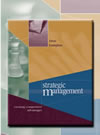 Strategic Management: Strategic Managment Gregory G. Dess,
University of Texas at Dallas
G.T. Lumpkin,
University of Illinois--Chicago
Effective Strategic Leadership: Fostering Corporate Entrepreneurship and New Venture Creation
References| 1. Gentlemen, start your engine. 1996. Fortune, September 30; Useem, J. 1998. Exotic auto venture is $24-million nonstarter. Inc., June 29; Wouk, V. 1997. Hybrid electric vehicles. Scientific American, October:17.
2. Useem, op. cit., p. 29.
3. Fromartz, S. 1998. How to get your first great idea. Inc., April 1:91–94; Vesper, K. H. 1990. New venture strategies, 2nd ed. New York: Prentice Hall.
4. Hof, R. D. 2000. E-marketplace: eLance. Business Week E.Biz, June 5:68–72.
5. Fishman, C. 1998. Sustainable growth—Interface, Inc. Fast Company, April 1998:136; Hawken, P., Lovins, A. & Lovins, H. 2000. Natural capitalism. Boston: Back Bay Books; see also www.ifsia.com.
6. Judge, P. C. 2000. Professor Ulrich’s excellent adventure. Fast Company, August:248–57.
7. Himelstein, L. 2001. The silicon brigade signs up. Business Week, October 8:61.
8. Carey, J. & Yang, C. 2001. From smart to brilliant weapons. Business Week, October 8:62–63.
9. Gaglio, C. M. 1997. Opportunity identification: Review, critique and suggested research directions. In J. A. Katz, ed. Advances in entrepreneurship, firm emergence and growth, vol. 3. Greenwich, CT: JAI Press: 139–202; Hills, G. E., Shrader, R. C. & Lumpkin, G. T. 1999. Opportunity recognition as a creative process. Frontiers of entrepreneurship research, 1999. Wellesley, MA: Babson College: 216–27; Long, W. & McMullan, W. E. 1984. Mapping the new venture opportunity identification process. Frontiers of entrepreneurship research, 1984. Wellesley, MA: Babson College: 567–90.
10. Bennet, E. 2000. Fungus fanatic. Philadelphia Business Journal, February 18; Greco, S. 1998. Where great ideas come from. Inc., April:76–86.
11. Timmons, J. A. 1997. Opportunity recognition. In W. D. Bygrave, ed. The portable MBA in entrepreneurship, 2nd ed. New York: John Wiley: 26–54.
12. Cusumano, M. 1999. Why Iridium fell to earth: Lessons from a debacle. Computerworld, September 20:30; Finkelstein, S. & Sanford, S. H. 2000. Learning from corporate mistakes: The rise and fall of Iridium. Organizational Dynamics, 29(2):138–48.
13. Schonfeld, E. 2000. Going long. Fortune, March 20:172–92.
14. Warshaw, M. 2000. The thing that would not die. Inc. Tech, 1:89–100.
15. Welles, E. O. 2001. Hell-bent for lather. Inc., September:50–52.
16. Fitzgerald, M. 2001. Top ten entrepreneurs: Ray Ozzie. Red Herring, August 1:62.
17. The state of small business: A report of the President, 1992. 1992. Washington, DC: U.S. Government Printing Office: 65–90.
18. Romanelli, E. 1989. Environments and strategies of organization start-up: Effects on early survival. Administrative Science Quarterly, 34(3):369–87.
19. Fromartz, S. 1998. How to get your first great idea. Inc., April 1:91–94; Grossman, J. 1999. Courier’s foreign niche. Inc., October 15:57.
20. Wallace, B. 2000. Brothers. Philadelphia Magazine, April:66–165.
21. Zacharakis, A., Reynolds, P. D. & Bygrave, W. D. 1999. Global entrepreneurship monitor—National entrepreneurship assessment: United States of America 1999 Executive Report. Kansas City, MO: Kauffman Center for Entrepreneurial Leadership.
22. Seglin, J. L. 1998. What angels want. Inc., 20 (7):43–44.
23. See walkabouttravelgear.com.
24. Stuart, A. 2001. The pita principle. Inc., August:58–64.
25. Jami Morse. 2000. Working Woman, June:68.
26. Altman, H. 1981. A business visionary who really delivered. Nation’s Business, November:50; Colvin, G. 1981. Federal Express dives into air mail. Fortune, June 15:107.
27. Fraser, J. A. 2001. The money hunt. Inc., March:49–63.
28. Osborne, D. M. 2001. Dear John. Inc., May:45–48.
29. Stinchcombe, A. L. 1965. Social structure in organizations. In J. G. March, ed. Handbook of organizations. Chicago: Rand McNally: 142–93.
30. Fast Pack 1999. 1999. Fast Company, February–March:139.
31. Eisenhardt, K. M. & Schoonhoven, C. B. 1990. Organizational growth: Linking founding team, strategy, environment, and growth among U.S. semiconductor ventures, 1978–1988. Administrative Science Quarterly, 35:504–29.
32. Dubini, P., & Aldrich, H. 1991. Personal and extended networks are central to the entrepreneurship process. Journal of Business Venturing, 6(5):305–33.
33. Vogel, C. 2000. Janina Pawlowski. Working Woman, June:70.
34. Tanner, J. 2000. Meals on wheels (and rails and water). Inc., May:124–26.
35. Briody, D. 2001. Top ten entrepreneurs: Bill Nguyen. Red Herring, August 1:58–60.
36. Himanshu "Sue" Bhatia. 2000. Working Woman, June:91; see roseint.com.
37. Guth, W. D. & Ginsberg, A. 1990. Guest editor’s introduction: Corporate entrepreneurship. Strategic Management Journal, 11:5–15.
38. Pinchot, G. 1985. Intrapreneuring. New York: Harper & Row.
39. Collins, J. C. & Porras, J. I. 1997. Built to last. New York: HarperBusiness; Rabinovitz, J. 2000. Venture capital, inc. Industry Standard, April, 17:88–90.
40. Quinn, J. B. 1992. Intelligent enterprise. New York: Free Press.
41. Holstein, W. J. 2000. Dump the cookware. Business 2.0, May 11:68–73.
42. Crocket, R. O. 2001. Chris Galvin shakes things up—again. Business Week, May 28:38–39.
43. Cross, K. 2001. Bang the drum quickly. Business 2.0, May 1:28–30.
44. Markham, S. K. & Aiman-Smith, L. 2001. Product champions: Truths, myths and management. Research Technology Management, May–June:44–50.
45. Burgelman, R. A. 1983. A process model of internal corporate venturing in the diversified major firm. Administrative Science Quarterly, 28:223–44.
46. Hamel, G. 2000. Leading the revolution. Boston: Harvard Business School Press.
47. Shane, S. 1994. Are champions different from non-champions? Journal of Business Venturing, 9(5):397–421.
48. Covin, J. G. & Slevin, D. P. 1991. A conceptual model of entrepreneurship as firm behavior. Entrepreneurship Theory and Practice, 16(1):7–24; Lumpkin, G. T. & Dess, G. G. 1996. Clarifying the entrepreneurial orientation construct and linking it to performance. Academy of Management Review, 21(1):135–72; McGrath, R. G. & MacMillan, I. 2000. The entrepreneurial mindset. Boston: Harvard Business School Press.
49. Lumpkin, G. T. & Dess, G. G. 2001. Linking two dimensions of entrepreneurial orientation to firm performance: The moderating role of environment and life cycle. Journal of Business Venturing, 16:429–51.
50. The discussion of radical and incremental innovations draws from Damanpour, F. 1996. Organizational complexity and innovation: Developing and testing multiple contingency models. Management Science, 42(5):693–76; Hage, J. 1980. Theories of organizations. New York: John Wiley.
51. Hamel, G. 1999. Bringing Silicon Valley inside. Harvard Business Review, 77(5):71–84.
52. Perman, S. 2001. Automate or die. eCompanyNow.com, July; Dell, M. 1999. Direct from Dell. New York: HarperBusiness.
53. Evans, P. & Wurster, T. S. 2000. Blown to bits. Boston: Harvard Business School Press.
54. Lieberman, M. B. & Montgomery, D. B. 1988. First mover advantages. Strategic Management Journal (Special Issue), 9:41–58.
55. The discussion of first mover advantages is based on several articles, including Lambkin, M. 1988. Order of entry and performance in new markets. Strategic Management Journal, 9:127–40; Lieberman & Montgomery, op. cit., pp. 41–58; Miller, A. & Camp, B. 1985. Exploring determinants of success in corporate ventures. Journal of Business Venturing, 1(2):87–105.
56. Moore, G. A. 1999. Crossing the chasm, 2nd ed. New York: HarperBusiness.
57. Tesler, L. 2001. Why the Apple Newton failed. www.techtv.com/print/ story/0,23102,3013675,00.html; Veitch, M. 1998. Apple kills off Newton PDA. http://news.zdnet.co.uk/story/printer/0,,s2067739,00.html.
58. Quoted in Collins & Porras, op. cit.; see also www.sony.com.
59. Hardy, Q. & Godwin, J. 2000. Other people’s money. Forbes, August 7:116–18.
60. The failure of new media. 2000. The Economist, August 9:53–55.
61. Carvell, T. 1997. The crazy record business: These prices are really insane. Fortune, August 4:109–16.
62. Bogan, C. E. & English, M. J. 1994. Benchmarking for best practices. New York: McGraw-Hill; Mochari, I. 2001. Steal this strategy. Inc., July:62–67.
63. Helman, C. 2001. Stand-up brand. Forbes, July 9:27.
64. Keenan, F. & Mullaney, T. J. 2001. Clicking at Graybar. Business Week, June 18:132–34.
65. Weintraub, A. 2001. Make or break for Autobytel. Business Week e.biz, July 9:EB30–EB32; see also www.autobytel.com.
66. Coy, P. & Vickers, M. 2001. How bad will it get? Business Week, March 12:36–42.
67. Drucker, P. F. 1985. Innovation and entrepreneurship. New York: HarperBusiness:109–10
|
|




 2002 A McGraw-Hill Online Learning Centre
2002 A McGraw-Hill Online Learning Centre